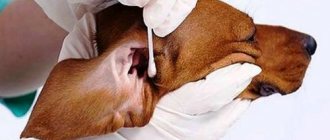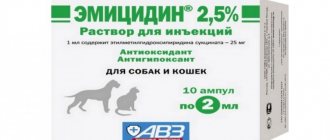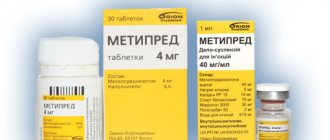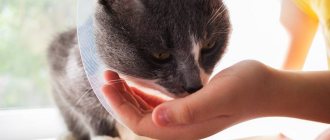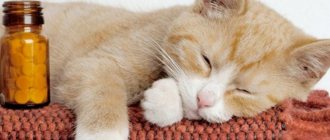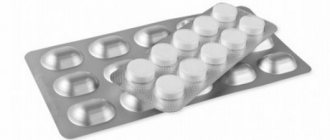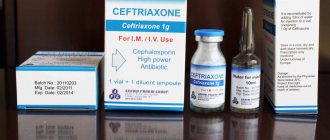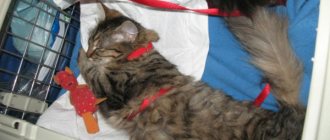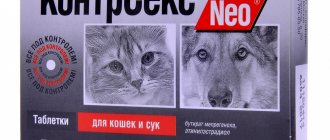Properties, principle of operation
Ivermek for cats
The product is completely safe for people and well tolerated by animals. This is one of the most modern drugs for cats, which gives quick results and has an affordable price.
The medicine has no unpleasant odor and does not cause concern to the cat, which greatly simplifies the treatment procedure.
The active substance included in the drug destroys the main types of cutaneous, intradermal, and internal parasites. The component easily penetrates the bloodstream, spreading evenly throughout the body, affecting parasites in various tissues and organs.
The effect of the composition lasts for 2 weeks. When using the medicine in the form for external use, distribution through the bloodstream does not occur, so the therapeutic effect is expressed only against cutaneous pathogens.
Important! Strict adherence to the dosage is necessary, since the active component is toxic and completely safe only if used in an amount individually selected for a particular cat.
Factors contributing to infection
If sanitary standards are not followed on the farm, the risk of contracting lichen reaches 90%. The pathology can be quickly transmitted from infected individuals to healthy animals.
There are some factors that increase the likelihood of developing trichophytosis. These include:
- insufficient disinfection measures for processing instruments used in caring for animals and premises;
- high humidity in stalls;
- large crowding of cows in the premises;
- insufficient lighting;
- lack of vitamins;
- poor quality care.
Important! Transmission of a pathogenic microorganism can continue even during the incubation period, as long as there are no obvious signs of disease on the animal’s body.
Indications for use
Odorless medicine
Injection solution eliminates all types of external parasites, as well as the following pathologies caused by nematodes:
- toxascariasis;
- intestinal gadfly;
- uncinariasis;
- hookworm.
In the form for external use, Ivermek is effective only against the following lesions:
- otodectosis;
- psoroptosis;
- demodicosis;
- notoedrosis;
- sarcoptic mange.
The drug is not used for prophylactic purposes. It is used exclusively as a medicine for severe damage, when other formulations are not effective enough.
Be sure to read:
Otodectin: instructions for use for cats, dosage, indications and contraindications
Where is trichophytosis most often found?
Fungal bacteria often affect the face, neck and back of cattle. In individuals with a weakened immune system, the disease can spread throughout the body. The mammary glands and limbs become covered with lichen in rare cases.
If a livestock breeder is infected with trichophytosis from pets, characteristic signs appear on the skin of the hands and on the head (in the hair), since these areas of the body are most often in contact with animals. If cows are milked manually, pathogens can easily be transferred to the head from an infected individual.
Directions for use, dosage for cats
The method of use of the drug depends on the form in which the drug is prescribed.
Injections are carried out intramuscularly into the hind leg in the thigh area. The bottle is shaken before taking the medicine. An insulin syringe should be used for the injection. In most cases, one injection is enough to achieve a therapeutic effect.
If necessary, repeated administration is carried out after 10 days. The injection dose is calculated based on the cat’s weight in the ratio of 0.1 ml of medication per 5 kg of weight. In parallel, the use of drugs that support the liver for cats is indicated.
Injections are carried out intramuscularly into the hind leg in the thigh area
Gel and spray are prescribed externally to kill ticks, fleas and lice-eaters. The drug is applied to the cat's body, avoiding the muzzle area. Afterwards, it is unacceptable for the pet to lick the composition, for which a collar is placed around the neck. The dose of the drug in the form of a spray or gel is 0.2 ml per 1 kg of weight.
Treatment is carried out several times with intervals of 3-5 days, depending on the instructions of the veterinarian. The whole body cannot be treated at once. Because of this, in case of extensive tick infestation, treatment is carried out first on one side, and after 1-2 days on the other.
This treatment regimen is additionally discussed with a veterinarian. For otitis media, the medication is applied into the ear cavity in a dose specified by a specialist.
Important! The product is not used as prophylaxis.
Description of the veterinary drug
The veterinary drug is obtained by fermentation of the fungus Streptomyces avermitilis. Contains vitamin E, ivermectin. Ivermek is produced in the form of a sterile, colorless, light yellow opalescent injection solution, packaged in hermetically sealed glass bottles of 1, 10, 20, 50, 100, 500 ml. Each bottle indicates the series, manufacturer, date of manufacture, expiration date, volume, method of use, the inscriptions “For animals”, “Sterile”, the active ingredients and their proportions are indicated. The boxes must contain instructions for use.
Ivermek for animals
One ml of Ivermec contains 10 mg of ivermectin, 40 mg of vitamin E. The unique water-dispersed form ensures a high degree of effectiveness of the veterinary drug.
Ivermek is stored in closed packaging out of the reach of children at a temperature of 0 to 25 degrees Celsius. If stored correctly, the shelf life of the veterinary drug from the date of release is two years. After opening the bottle, Ivermek should be used within 24 hours. After the expiration date, the medication must be disposed of.
Ivermek belongs to the group of moderately dangerous pharmacological drugs. Before use, consult your veterinarian, carefully read the instructions, and strictly adhere to the recommended dosages. When working with veterinary medicine, follow the rules of asepsis.
Contraindications and possible side effects
There are contraindications to the use of the product.
According to the instructions, the drug is strictly prohibited from being taken in any form in the following cases:
- the period of gestation and feeding of kittens by the cat (the drug affects the development of the cubs and penetrates into the milk);
- infectious pathologies in the animal and the recovery period after them;
- allergic reaction to the components of the drug;
- less than 3 months old.
If your cat has liver disease, you must inform your veterinarian about this, since you must use Ivermec for cats with extreme caution.
Be sure to read:
Piperazine for cats: dosage, how it works, indications and contraindications, instructions for use
Side effects of the drug may include the following:
- salivation;
- vomit;
- profuse lacrimation;
- tremor.
Side effects from the use of the drug usually occur if the dosage of the antiparasitic drug is exceeded.
If the cat’s condition is serious, spontaneous urination, fecal loss, and impaired coordination of movements may also develop due to an overdose. Treatment for this condition is not required, but Ivermek cannot be reused.
What kind of disease is this
For calves, this disease is dangerous because it inhibits the development of a young body. Individuals stop gaining weight and suffer from disturbances in the functioning of the nervous system. Ringworm is observed in 99% of the cattle population. Moreover, the pathogen that causes the disease is resistant to external factors and can remain viable for 8 years in a favorable environment. Therefore, in order to prevent re-infection of livestock, when the animals are completely cured, complete disinfection of the premises must be carried out.
Cattle lichen has another name - trichophytosis. This disease manifests itself when the skin is damaged by pathogenic microorganisms of a fungal nature. The infection can be transmitted to all inhabitants of the livestock farm, including cows. It is important that this pathology can also affect humans. In other words, an animal can catch a disease and then infect its owner, or in the reverse order. In addition, transmission to other farm animals living in the barnyard is possible.
The causative agent of lichen (trichopytosis) is two types of fungal microorganisms, called microsporum and trichophyton. These pathogens are characterized by excellent resistance to external factors and are able to progress in the cellular tissue of the epidermis for about 5 years. And fungal spores remain viable for 8 years in rooms where animals are kept or the surfaces of feeders.
Under favorable conditions, a fungus develops from spores, which subsequently affects the skin of the cow. For this reason, an important condition when keeping cattle is regular disinfection of all equipment to protect the barnyard from infection with all kinds of diseases, including trichophytosis.
Adult cows tolerate this disease more easily than calves, since lichen can have a negative impact on the growth and development of animals. In the absence of timely assistance and adequate therapy, under the influence of trichophytosis, livestock is depleted, and a decrease in the productivity of cows is also observed.
There are several varieties of lichen according to the pathology:
- bubbly;
- superficial;
- deep (follicular);
- erased.
The incubation period is sometimes about 30 days, so it is quite difficult to detect the disease in a cow at an early stage. Trichophytosis in young cattle appears in the muzzle area, and in mature animals in the chest, neck, and inner thighs. In calves, a deep form of lichen is often determined, and in adult bulls and cows, it is erased.
Composition and release form
Release forms Ivermek
The medicine is produced in the form of an injection solution, spray and gel. The required form of medication will be prescribed by your veterinarian.
The main active component is ivermectin, which stimulates the body's production of butyric acid, which is deadly to parasites. Additionally, the injection composition includes vitamin E. The remaining substances in the drug are auxiliary.
Symptoms of the disease
The disease has characteristic symptoms that are difficult to confuse with other pathologies. If you have doubts whether it is really trichophytosis, you should seek advice from a veterinarian or livestock breeder with experience in breeding cattle. Even a simple veterinarian from the city who has to treat dogs and cats can determine the presence of ringworm in farm animals.
The presence of the following signs indicates that livestock is infected with a similar fungal disease:
- peeling of the epidermis in the area affected by the pathogen;
- a grayish coating on the coat, where baldness subsequently appears;
- hair loss in the form of hairs cut off at the root, which is facilitated by the destruction of follicles by fungal microorganisms;
- oval or round bald spots of different sizes.
As the disease progresses, animals become irritable and aggressive due to constantly disturbing itching. In addition, infected individuals appear emaciated, as their appetite decreases and digestive function is impaired.
In the absence of timely treatment, the well-being of the cows worsens, but if a secondary infection occurs, there is a risk of death of the sick individual.
Diagnostic measures
Diagnosing the disease is simple; most often, the development of trichophytosis can be determined by examining the animal. In rare cases, the development of an atypical pathology is observed. In such a situation, it is necessary to examine the scraping. This is necessary to confirm or exclude the presence of fungal infections. In addition to scraping, a small amount of the cow's hair is collected, and it should be pulled out rather than cut.
Cut hairs do not allow an accurate diagnosis, since fungal microorganisms live in the skin tissues and follicles, and not outside on the hairs.
Differential diagnosis should also be carried out to distinguish trichophytosis from scabies, since these diseases have similar symptoms.
Preventive actions
Trichophytosis is not a particularly dangerous pathology. If you approach treatment correctly, you can easily cope with the problem. Mortality from such a disease is very rare, although there is a risk of material damage to the farm. For this reason, special measures are recommended on livestock farms to help prevent the development of lichen.
Prevention in this case consists of:
- regular removal of livestock excrement;
- treating the barn with disinfectants according to schedule;
- thorough washing, cleaning and disinfection of instruments used in caring for animals and cleaning premises.
To keep cattle, spacious stalls should be used, which should have at least a simple ventilation system. It is necessary to ensure that the premises are dry, warm and sufficiently lit.
Important information about ringworm
One of the characteristics of trichophytosis is that the disease can be easily transmitted from animals to humans. So, if an infected individual is detected among the livestock on a farm, in addition to other measures, measures should be taken to prevent infection of service personnel. While working on such a farm, employees need to wear special clothing.
When treating the skin of sick animals with medications, it is imperative to protect your hands with gloves. The same applies to cleaning cow care items, as well as cleaning the barn itself.
Naturally, livestock farms need to be equipped with showers. Service personnel must take a shower each time they finish their work shift. If you find spots on the skin characteristic of the disease, you should definitely consult a veterinarian. Until a person recovers, he is prohibited from working in a cowshed.
Trichophytosis is dangerous because it quickly spreads over the surface of the cow’s body; the disease affects the skin more and more over time (if treatment is not started in a timely manner).
Under the influence of the fungus, the immune system is suppressed, which increases the likelihood that a secondary bacterial infection will occur. Therefore, treatment must be started immediately when the first signs are detected, and it must be completed. Particular attention should be paid to prevention so that the unpleasant disease does not affect healthy individuals in the herd. [youtube.player]
